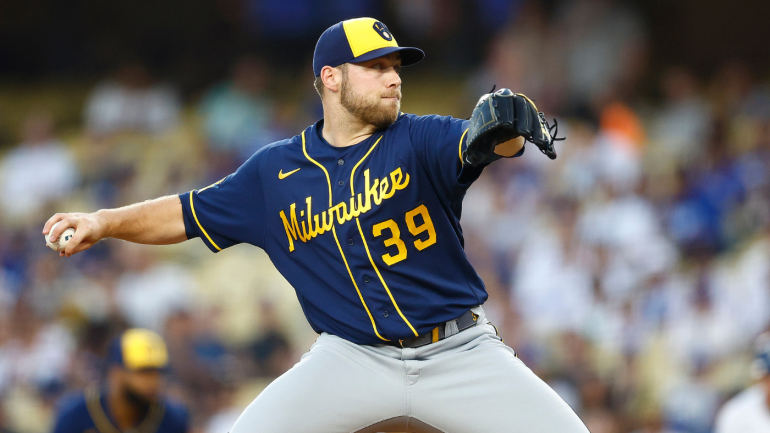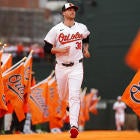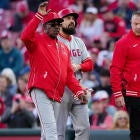
The Baltimore Orioles acquired Cy Young-winning righty Corbin Burnes in a blockbuster trade with the Milwaukee Brewers on Thursday night. The Brewers will receive two young players, in shortstop Joey Ortiz and left-handed pitcher DL Hall, as well as a competitive balance round draft pick in July's draft.
Adding Burnes caps an eventful week for the Orioles, who will soon be under the ownership of David Rubenstein. The Brewers are also at the cusp of a new beginning. It's seemingly inevitable that neither Burnes nor Brandon Woodruff, non-tendered at the start of the offseason, will be on the roster next year. Factor in the departures of former top executive David Stearns and manager Craig Counsell, and the Brewers will have a different identity heading forward.
As always, we here at CBS Sports have offered instant analysis on the deal, complete with write-ups for every moving player and grades for both teams.
Here, again, is the deal in whole:
- Orioles receive: RHP Corbin Burnes
- Brewers receive: SS Joey Ortiz, LHP DL Hall, draft pick No. 34
Now, onto the fireworks factory.
Orioles grade: A
We've been waiting, waiting, and waiting a little longer for the Orioles to consolidate their considerable position player depth into an impact starter. When we wrote last month about four blocked prospects who needed a change of scenery, we noted how a rival executive joked the piece could have been written only about Orioles prospects. That says a lot about Baltimore's farm.
At last, the Orioles have done it -- at least to an extent, as they traded arguably the most blocked shortstop prospect in baseball. (Poor Ortiz was caught behind and between Gunnar Henderson and Jackson Holliday. Good luck.) In theory, they could make another trade for Dylan Cease (or whomever) without emptying their coffers of high-quality position-player prospects. Must be nice.
Corbin Burnes, 11th, 12th and 13th Ks. pic.twitter.com/s1iUK1Eh53
— Rob Friedman (@PitchingNinja) July 15, 2023
Burnes, 29, has been one of the best starters in baseball dating back to 2020. His 146 ERA+ over that time ranks fourth out of the 67 pitchers with at least 75 starts, trailing only Max Fried, Clayton Kershaw, and the aforementioned Woodruff. He won the 2021 Cy Young Award and he's finished eighth or better in the three other seasons, speaking to his quality and consistency.
Burnes relies heavily on a mid-90s cutter as well as a swing-and-miss curveball and a sidespinning changeup. It may not be conventional for a starter to eschew throwing two- or four-seam fastballs often, but it doesn't make a difference here. Indeed, Burnes does everything you could want a top-flight starter to do. He pounds the zone, he misses bats, and he's an adept contact manager -- to the extent that his average exit velocity against has ranked in the top 8% of the league in two of the past three years.
Where things get interesting now is what the Orioles intend to do about Burnes' impending free agency. Remember, Baltimore's books are wide open. They have just $2 million in guarantees for next season (both in the form of club option buyouts) and nothing beyond that. There's no legitimate financial reason for the Orioles to shy away from retaining Burnes on a long-term basis.
Will the Orioles actually make it so? Perhaps this proves overzealous, but we feel more optimistic about their chances than we would have a week ago.
Brewers grade: C
The Brewers' front office is good at what it does. They've either posted a winning record or made the postseason in each of the last seven seasons. They've done that while mostly fielding payrolls that rank in the bottom third of the league, and without picking higher than 15th in the draft since 2017. And yet, this return feels a little light, like it's missing that one last piece.
Maybe the Brewers are just higher on the players they received, or maybe they were simply without the necessary leverage to coax more from the Orioles. Try as they did to convince other teams they were willing to head into the season with Burnes in tow, the idea of waiting to trade him until the deadline -- or possibly not at all if they were competitive through the summer -- never added up. The minute he took the mound in the regular season, his trade value would have taken a massive hit with the loss of possible draft-pick compensation.
With that in mind, maybe this deal falling short of forecasts-- and you can argue that the "C" grade is a touch generous -- should have been the expectation. That doesn't make it easier to stomach if you're a Brewers fan who was hoping for a few shiny prospect rankings in return. If there is an upshot here, it's that Ortiz and Hall are both ready for big-league duty.
Ortiz, 25, appeared in 15 big-league games last season. He didn't impress during his cameo, but that's OK. He performed better in the minors, batting .321/.378/.507 in 88 Triple-A games. As we explained in our report on him last month, he's an outstanding defensive infielder with some offensive promise. To directly quote ourselves: "Ortiz hit more than 45% of his batted balls over 95 mph. Although he's never going to be a big home-run hitter -- his average launch angle was 8.5 degrees -- he should be able to collect enough hits and walks to avoid being viewed as the modern Jack Wilson." In so many words, pegging Ortiz as a second-division shortstop seems reasonable.
Our expectation is that Ortiz is going to serve as the Brewers' shortstop of the future sooner than later -- perhaps even come Opening Day. Technically Willy Adames is under team control for another season, but there's nothing stopping the Brewers from making a move there now that they've broken the seal with a Burnes deal and have -- in our eyes -- reduced their chances of winning the National League Central.
Hall, 25, has appeared in 29 games, all but one in relief, over the last two seasons. He's compiled a 4.36 ERA (94 ERA+) and a 3.82 strikeout-to-walk ratio. The book on Hall has been the same for some time. He has starter-quality stuff and reliever-quality command.
Hall's fastball sits in the mid-90s and plays faster thanks to a deep release point that sees him generate seven feet of extension from the pitching rubber. His main secondary pitch has been a slider that has drawn more than 30% whiffs at the big-league level. He also has a changeup and a curveball.
DL Hall, K'ing the Side. 🔥 pic.twitter.com/1vFygzpzjq
— Rob Friedman (@PitchingNinja) August 13, 2022
It's possible the Brewers view Hall as a potential starter, or at least a multi-inning reliever type. For him to work prolonged outings is a matter of strike-throwing. His delivery features a very long arm swing that can be difficult to repeat, resulting in him walking more than five batters per nine innings in the minors. The Brewers have excelled in getting the most from their pitchers in recent years -- some of our sources have talked up Cameron Castro, Milwaukee's vice president of player development, as a key on that end -- and it'll be up to their coaches and instructors to get the most from Hall.
It's safer to project Hall as a reliever heading forward. Perhaps the Brewers will wind back the clock, in a sense, and model his role after what they did with Josh Hader in his earlier days. Or maybe they'll find a way to unlock his middle-of-the-rotation upside. Spring, brimming with the answers to the winter's most pressing usage questions, is only a skip and a hop away.
As for the 34th pick in the draft, we'll have to wait and see there, too. Historically, that spot has generated 4.4 Wins Above Replacement on average, according to Baseball Reference. For comparison's sake, Burnes has averaged 4.3 WAR the last three seasons. Six of the 59 players selected 34th have cleared 10 WAR. Maybe the Brewers end up beating the odds, but probably not.






















